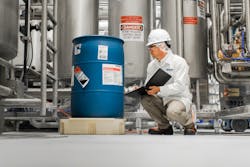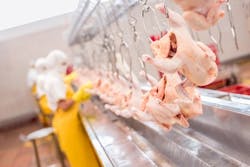About the author:
Ann Gent is senior vice president and general manager of Ecolab Food & Beverage, North America. Gent can be reached at [email protected].
At the outset of the 2020s, the global food system is more complex than ever. Billions of people have escaped poverty since the turn of the century. While issues of hunger remain, they have more to do with lack of income than lack of available food. As more people join the middle class, their new status is reflected in their diets, with the demand for affordable and accessible protein increasing globally.
At the same time, the U.N. projects that the world’s population will be close to 10 billion by 2050.
Already, the combination of more people and richer lifestyles is colliding with the planet’s limits. The accelerating digital transformation is changing how the world grows, processes and distributes food. And the X-factor is climate change. It is happening and companies along the food supply chain are among the first to feel the effects, but it cannot be predicted exactly what the ultimate impacts will be.
Amid all of these conflicting crosscurrents, consumers, investors and governments expect the food and beverage industry to feed everybody and to do it while lessening its resource use and help mitigate climate change. And—perhaps above all else now—do it safely. If the coronavirus pandemic has proven one thing, it is that the interconnected world will need to build increased resilience into its vital systems, including its food supply. Underlying everything is water. From farm to fork, global agricultural supply chains use 70% of the world’s available freshwater. If the world stays on the current course, the World Resources Institute projects that humanity will face a 56% freshwater deficit by 2030. The ability to feed a growing population will be significantly strained.
But the good news is this: food can be produced using less water. And one place the industry can save water is in food safety, where new technology can ensure a higher standard of performance and save cost.
Clean-in-Place Systems
Foodborne illnesses can cost a company millions of dollars in recalled products, can damage its reputation, and can have lasting impacts on consumer trust. A study by John Hopkins Bloomberg School of Public health found that food safety issues cost America’s food industry more than $55 billion each year.
Food safety has traditionally been a manual process, with workers cleaning production spaces and equipment by hand. Over the decades, technology changed that. Now, digital technology is accelerating the process even more, eliminating human error, creating efficiencies and saving water, energy and other resources.
One example of that principle is clean-in-place (CIP), the process of cleaning equipment internally without taking it apart. If CIP fails, companies risk ending up with contaminated products, costly recalls and consumer backlash. But there is a difference between effectiveness and efficiency. A system that is effective in ensuring safety and quality may still waste water, energy and cleaning products.
For a long time, users were quite literally in the dark about their systems’ efficiency. Periodic manual checks gave them snapshots on performance but fell far short of full insight. Increasing the frequency of manual checks to a meaningful degree is unpractical and costly because it would entail stopping production regularly to have people inspect the insides of the equipment.
Enter Automated CIP Technology
Before the dawn of sensor technology and IoT, most companies assumed close to 100% of their washes were running optimally. But after installing an automated system, they discovered ranges of 30% to 70% efficiency. There are enormous margins for progress and savings.
Automated CIP monitoring—like that provided by companies such as Ecolab—marries the Internet of Things (IoT) and Big Data. The system is built on the St. Paul, Minnesota-based company’s 3D Trasar technology. Connected 3D Trasar sensors detect the concentration of cleaning and sanitizing chemicals in water in real-time. If anomalies are found, corrective action can be taken immediately.
Meanwhile, data is sent back to Ecolab, where algorithms scour it for patterns and deviations in the wash protocols. This enables the company to put its experts to work helping end-users make real-time corrections as well as long-term improvements to CIP systems.
Over 12 months of using this technology for CIP, a plant in southern Minnesota owned by a well-known dairy brand saw product quality variability decrease by 55%. The facility saved 1,295 hours of cleaning time, 3,000 gallons of CIP cleaning product, 963,750 gallons of water and 1,215 kWh of electricity, translating to 1,847 pounds of avoided greenhouse gas emissions.
Meanwhile a Southwestern U.S. soda brand plant monitored just one production line with the sensors for CIP and found an issue with filter cleaning. After the necessary improvements, the plant reported 200 hours in reduced cleaning time, 875,000 gallons of water saved and a $369,000 total estimated benefit thanks to 24/7 monitoring, including $8,000 in cost avoidance due to reduced maintenance.
Better Outcomes With a Quarter of the Water
One part of the industry that places an especially high premium on food safety is the meat and poultry sector. As global middle classes have grown over the past several decades so has demand for protein. And with supply chains growing longer and more complex, food makers place even more of a premium on keeping the risk of pathogens at bay. But that takes copious amounts of water, so meat and poultry processors are always on the lookout for ways to lower their water use.
Take a typical poultry plant that operates two production lines. Each line has at least one Inside-Outside Bird Washer (IOBW) unit, which is a pressure washer that sprays each bird’s exterior and inner cavity to get rid of bacteria and other contaminants. An IOBW typically uses 80 gallons of water per minute, and each line has two units. That means that the average plant uses 320 gallons per minute on washing the birds alone, or almost 20,000 gallons per hour.
Much like CIP monitoring solutions, Ecolab developed a product called Inspexx/Water Reuse System to address this need. It can be used to reduce the wash wter amount by 75%. Ordinarily, water that left the IOBW would be discharged to the municipal water treatment system or reused once in upstream equipment. This system, however, recirculates the water to the IOBW after mixing it with the Inspexx 250 antimicrobial chemistry. As a result, the same water can be reused up to seven times. The chemistry of this product is chlorine-free, which is a must for many consumers. After use, it breaks down into water, oxygen and acetic acid, also known as vinegar.
The system, which can be washed using CIP, is not a closed loop, because a portion of the washing water is carried out by the birds themselves, most of it inside their cavities. The only new water introduced is what is needed to make up for those losses. This way, a poultry line consumes only 44 gallons of water per minute instead of 320 gallons, which is a significant gain in efficiency.
Since introducing this system at one of its plants, a well-known chicken brand belonging to one of the world’s largest poultry companies has saved 68 million gallons of water per year, equivalent to the annual drinking water needs of more than 270,000 people. The facility is also saving $250,000 per year, has eliminated the need for a $500,000 investment in additional water treatment capacity and increased its production by almost 20%, churning out more birds per minute with the same amount of water.
These examples demonstrate that the industry can indeed deliver on the demand for more and safer food while lowering its environmental impacts. With these new systems, food safety and sustainability come together. That is something consumers love, and it is good for the bottom line.

